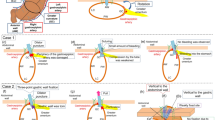Abstract
Introduction: Percutaneous endoscopic gastrostomy (PEG) is the commonest method of long-term enteral nutrition. In the UK there is no nationally funded framework to provide community support for patients with gastrostomies.
Objectives: To assess the hospital support required and the complications occurring in a cohort of patients discharged into the community with a gastrostomy in-situ.
Design and setting: We prospectively collected data between June and November 1998 regarding patients (n=87) with PEG complications in the community following discharge from two adjacent hospitals in South Yorkshire (Rotherham District General Hospital and the Royal Hallamshire Hospital).
Results: The mortality within this cohort during the study period was 17.2%. Of these 15 patients 10.3% (n=9) were thought to have died as a result of the progression of their disease, whilst in the other 6.9% (n=6) pneumonia was documented as the cause of death. Problems with gastrostomies requiring telephone advice occurred in 24.1% of patients and 65.5% necessitated a home visit. However during this period of 6 months, 23% of patients were admitted as an emergency, accounting for 61 in-patient days. All were from nursing or residential homes and the emergency occurred after normal surgery hours. General practitioners dealt with aspiration pneumonia in 25.2% of the cohort but other tube problems were referred to the endoscopy unit.
Discussion: This is the first study to specifically highlight the specialist intervention and support required by patients discharged into the community with PEGs, a group for whom there is often no formal aftercare. A specialist nurse or dietician could establish a liaison service focusing on primary care and using hospital resources when appropriate. This study provides further evidence to support the recommendations for tube feeding made by the British Association for Parenteral and Enteral Nutrition.
European Journal of Clinical Nutrition (2001) 55, 610–614
This is a preview of subscription content, access via your institution
Access options
Subscribe to this journal
Receive 12 print issues and online access
$259.00 per year
only $21.58 per issue
Buy this article
- Purchase on Springer Link
- Instant access to full article PDF
Prices may be subject to local taxes which are calculated during checkout
Similar content being viewed by others
References
Ackerman RJ, Kemle KA, Vogel RL & Griffin RC (1998) Emergency department use by nursing home residents Ann. Emerg. Med. 31 749–757
Elia M (1995) An international perspective of artificial nutrition support in the community Lancet 345 1345–1349
Elia M, Cottee S & Holden C et al (1994) Enteral and parenteral nutrition in the community. A report by a working party of the British Association for Parenteral and Enteral Nutrition (BAPEN). Maidenhead: BAPEN
Gauderer MWL, Ponsky JL & Izant RJ (1980) Gastrostomy without laparotomy: a percutaneous endoscopic technique J. Paediatr. Surg. 15 872–875
Gibson SE, Wenig BL & Watkins JL (1992) Complications of percutaneous endoscopic gastrostomy in head and neck cancer patients Ann. Otol. Rhinol. Laryngol. 101 46–50
Grant M, Rudberg MA & Brody JA (1998) Gastrostomy placement and mortality among hospitalized Medicare beneficiaries J.A.M.A. 279 1973–1976
Heaney A & Tham TCK (2000) General practitioners views on percutaneous endoscopic gastrostomies Gut 46(Suppl 2) A1 9
Howard L, Ament M, Fleming R, Shike M & Steiger E (1995) Current use and clinical outcome of home parenteral and enteral nutrition therapies in the United States Gastroenterology 109 355–365
James A, Kapur K & Hawthorne AB (1998) Long-term outcome of percutaneous endoscopic gastrostomy feeding in patients with dysphagic stroke Age Ageing 27 671–676
L'Estrange F (1997) An audit of adult patients on home enteral tube feeding in a region of Northern Ireland J. Hum. Nutr. Diet. 10 277–287
McNamara ER, Flood P & Kennedy NP (2000) Enteral tube feeding in the community: a survey of adult patients discharged from a Dublin Hospital Clin. Nutr. 19 15–22
Norton B, Homer-Ward M, Donnelly MT, Long RG & Holmes GKT (1996) A randomised prospective comparison of percutaneous endoscopic gastrostomy and naso-gastric tube feeding after acute dysphagic stroke Br. Med. J. 312 13–16
Office of Population, Censuses and Surveys (1993): The 1991 Census: Persons aged 60 and Over London: HMSO.
Parker T, Neale G & Elia M (1996a) Home enteral tube feeding in East Anglia Eur. J. Clin. Nutr. 50 47–53
Parker T, Neale G, Cottee S & Elia M (1996b) Management of artificial nutrition in East Anglia: a community study J. R. Coll. Physicians Lond. 30 27–32
O'Riordan S, Clark L, Arnold K, Parnell D, Jackson JHD & Swift CG (1999) Multidisciplinary percutaneous endoscopic gastrostomy clinic-one year on Age Ageing 28(Suppl 1) 2 3
Rabeneck L, Wray NP & Petersen NJ (1996) Long-term outcomes of patients receiving percutaneous endoscopic gastrostomy tubes J. Gen. Intern. Med. 11 287–293
Sanders DS, Carter MJ, D'Silva J, James G, Bolton RP & Bardhan KD (2000) Survial analysis in Percutaneous Endoscopic Gastrostomy: a worse outcome in patients with dementia Am. J. Gastroenterol. 95 1472–1475
Author information
Authors and Affiliations
Corresponding author
Rights and permissions
About this article
Cite this article
Sanders, D., Carter, M., D'Silva, J. et al. Percutaneous endoscopic gastrostomy: a prospective analysis of hospital support required and complications following discharge to the community. Eur J Clin Nutr 55, 610–614 (2001). https://doi.org/10.1038/sj.ejcn.1601197
Received:
Revised:
Accepted:
Published:
Issue Date:
DOI: https://doi.org/10.1038/sj.ejcn.1601197
Keywords
This article is cited by
-
Managing patients with gastrostomy tubes in the community: Can a dedicated enteral feed dietetic service reduce hospital readmissions?
European Journal of Clinical Nutrition (2012)
-
Complication rate lower after percutaneous endoscopic gastrostomy than after surgical gastrostomy: a prospective, randomized trial
Surgical Endoscopy (2006)



